Our Work
NTCA has been at the forefront of tiger conservation work in India. It’s work domain extends from on the ground protection initiatives to science based monitoring of tigers and their habitat using latest technological tools, indepedent assesssement of tiger reserves with MEE framework, financial and technical support to tiger reserves, creating inviolate space for wildlife while ensuring community development to international co-operation are the few thrust areas of NTCA.
The following links provide further information on the successful tiger conservation initiatives of NTCA.
India’s national tiger assessment is the largest biodiversity survey being carried out anywhere in the world. The fourth cycle of the assessment was undertaken in 2018 and 2019 using the best available science, technology and analytical tools.
In this cycle, recording of primary field data digitally through mobile phone application like M-STrIPES (Monitoring System for tigers – intensive protection and ecological status), that uses GPS to geotag photo-evidences, and survey information made this exercise more accurate, with smaller margins of human error.
Further, it involved the development of innovative technology like automated segregation of camera trap photographs to species using artificial intelligence and neural network models (software CaTRAT – Camera Trap data Repository and Analysis Tool). Program ExtractCompare that fingerprints tigers from their stripe patterns was used to count the number of individual tigers (>1 year old).
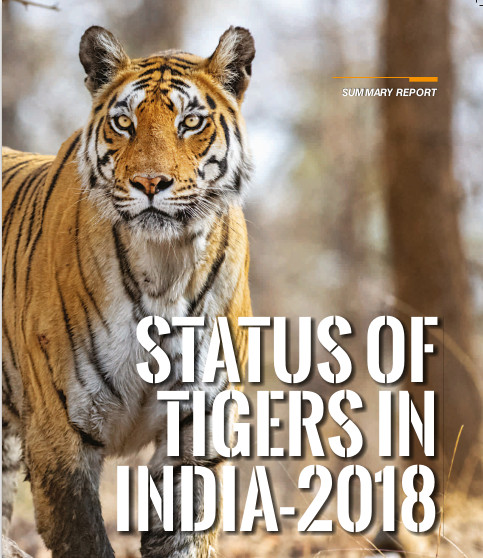
The unique feature of this cycle of assessment, in keeping up with “Digital India”, is the development and use of innovative technological tools in collection and processing of data to reduce human errors.
You may find more information on methodological details and summary of latest tiger estimation exercise in the report ‘Status of Tigers in India – 2018’ available under ‘Reports’ section of the website.
Management Effectiveness Evaluation
Survival of tigers is dependent on conservation and management efforts. To gauge the success of conservation efforts as well as to guide management inputs, it is important to assess the effectiveness of management of Tiger Reserves.
Post the disappearance of tigers in Sariska Tiger Reserve, the Government of India issued a directive to the Office of Comptroller and Auditor General (C&AG) of India and the Ministry of Environment, Forest and Climate Change (MoEFCC), Government of India to conduct an independent audit and place the report in the Parliament.
The Wildlife Institute of India (WII) in close collaboration with global experts and National Tiger Conservation Authority (NTCA) developed a framework for independent evaluation procedure to evaluate Tiger Reserves of the country. MEE Framework includes consideration of design issues, the adequacy and appropriateness of management systems and processes and the delivery of protected area objectives including conservation of values.
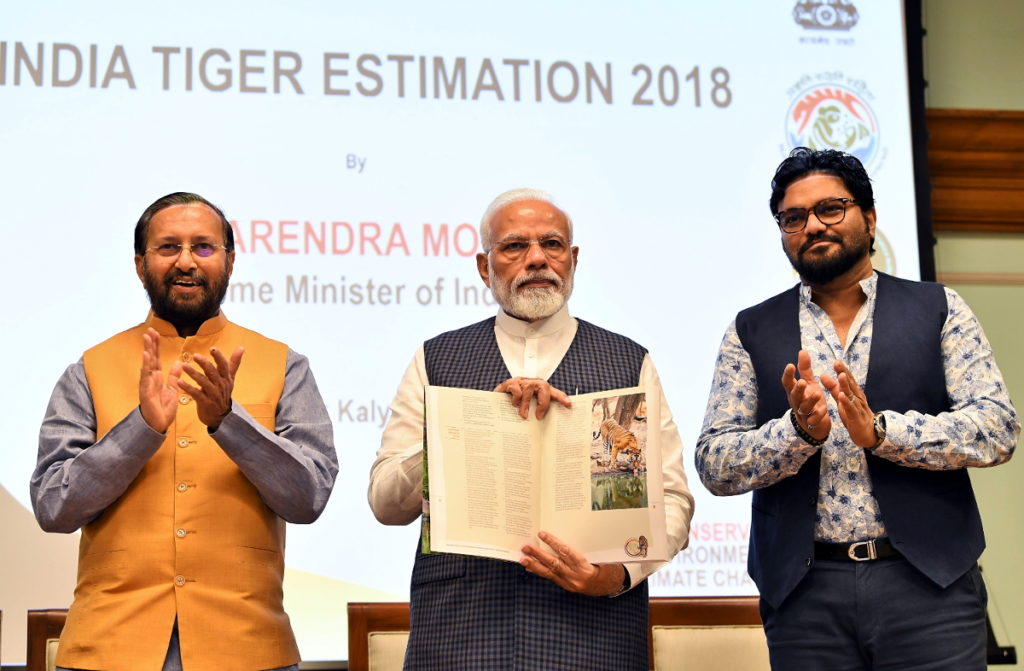
(Honourable Prime Minister of India releasing MEE report -2018 at New Delhi)
India is among the select countries in the world that have institutionalized the MEE Process. India made a beginning in evaluating the management effectiveness of its world heritage sites, national parks, wildlife sanctuaries and Tiger Reserves in 2006.Four repeat cycles of evaluation of Tiger Reserves Network have been made after every four years from 2006 to 2018 in India. This process is the most significant approach for tiger conservation and associated landscape connectivity conservation and management.
For more information on MEE, the details of past evaluation exercises and the reports, please visit the ‘Report‘ section of this website.
MSTrIPES (Monitoring System for Tigers: Intensive Protection and Ecological Status)
Currently the tiger reserves carry out law enforcement and ecological monitoring activities at regular interval, but the information generated is ad hoc and is rarely available to the tiger reserve managers in a format for informed decision making in an adaptive management framework. The “M-STrIPES” has been designed to addresses this void.It is a platform where modern technology is used to assist effective patrolling, assess ecological status and mitigate human-wildlife conflict in and around tiger reserves.
The MSTrIPES program uses Global Positioning System (GPS), General Packet Radio Services (GPRS), and remote sensing, to collect information from the field, create a database using modern Information Technology (IT) based tools, analyses the information using GIS and statistical tools to provide inferences that allow tiger reserve managers to better manage their wildlife resources.
Patrol module
The patrol module maintains a spatial database of patrol track logs, crime scenes with geotagged photographs and important observations made by field staff while on different types of patrol duties. The phone app allows visualization of all patrols in real time across the country when in cellular network connectivity. It also permits the guard to send geotagged location data to specified phone numbers in case of emergency (SOS) function. The mobile app can continue to operate in areas without phone network by using the phone’s inbuilt GPS and preloaded base maps.
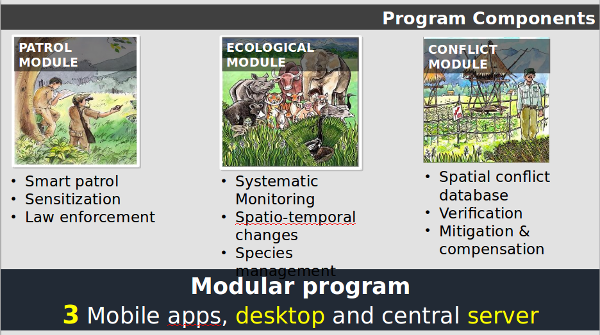
Ecological Module
The tiger reserves of India use a set of standardized protocols for ecological monitoring by field staff which include the following components:
1) Occupancy of carnivores and large ungulates,
2) Abundance estimation of ungulates,
3) Assessment of anthropogenic impacts and
4) Habitat assessment.
The ecological monitoring comprising of above components are implemented across the country at a spatial resolution of 20 square km every four years and twice annually within all tiger reserves and these standardized protocols are now part of ‘Ecological Module’ of MSTrIPES program.
Conflict Module
The conflict module of MSTrIPES addresses data recording, achieving, geotagging, and spatial analysis of human-wildlife conflict details. The app has provision for recording the details of attacks on humans, attacks on livestock, crop damage and property damage. This information on location, with spatially referenced photo-evidence, and extent of conflict allows wildlife managers to mitigate conflict with appropriate interventions.
The NTCA provides technical support to Tiger Reserves in addition to the funding support through on-going Centrally Sponsored Scheme – Project Tiger.
The technical support is provided in the following aspects of tiger conservation and management.
1. Approval of Tiger Conservation Plans
2. Formulation of normative standards for tourism activities and guidelines
3. Approve, coordinate research and monitoring of tiger, co-predators, prey and habitat
4. Assessment of infrastructure/ developmental projects within the tiger reserves
5. Capacity building and skill development of tiger reserve officials and staff
6. Standard Operating Procedures for managing the conflict situations, tiger mortality, active management and other thematic areas.
For more details please visit the ‘Document‘ section of the website.
“Project Tiger” was launched in April, 1973 with the objective “to ensure maintenance of a viable population of Tigers in India for scientific,economic, aesthetic, cultural and ecological values, and to preserve for all times, areas of biological importance as a national heritage for the benefit,education and enjoyment of the people”.
Item of Activities Supported
For fulfilling the objective, the Project Tiger, an ongoing Centrally Sponsored Scheme (CSS-PT) provides funding support to the tiger reserves under two broad categories namely: the ‘Non Recurring’ and Recurring’ activities.
Some of the activities covered under ‘Non Recurring‘ category are: strengthening of protection,deployment of armed squads in tiger reserves, creating basic infrastructure
for management, roads, wireless, civil works, habitat development,augmenting water resources, compensatory ameliorative measures for habitat restoration, eco-development, village relocation etc.
The ‘Recurring‘ activities considered for funding are: creation / deployment of local work force for patrolling/barriers,habitat improvement, providing salt licks, water facility, fire protection measures, maintenance of various items, publicity and extension and legal assistance.
Funding pattern
In case of North Eastern and Himalayan states, the funding pattern is 90:10 wherein the 90% of the scheme cost is provided by the Government of India as central assistance through NTCA and remaining 10% of the cost will be contributed by the State Government.
For rest of India, the cost of the scheme (CSS-PT) for recurring activities is shared as 50:50 basis and 60:40 basis for non-recurring activities by Central Government and State Governments.
The tiger reserves submit their proposals for funding through ‘Annual Plan of Operations (APO) to NTCA through States’s Chief Wildlife Warden (CWLW). The APOs are scrutinized at NTCA by taking into account the management prescriptions given in the ‘Tiger Conservation Plan (TCP) of respective Tiger Reserve. After vetting of the APO at various levels, funds are released from NTCA to the tiger reserves through State Governments.
The details of funds sanctioned to various tiger reserves are given here.
The NTCA has undertaken a number of milestone initiatives to strengthen tiger conservation in the country such as “active managerial interventions” for reintroducing tigers in areas where it has become locally extinct.
The tiger reintroduction has been a successful collaborative venture between the MoEF (through the NTCA), State Governments and the Wildlife Institute of India.
Since June, 2008, tigers have been successfully reintroduced in Sariska (Rajasthan) and Panna (Madhya Pradesh) Tiger Reserves.
Panna and Sariska Reintroductions
On 28.6.2008, a tiger (around 4 years of age) was chemically immobilized and airlifted to Sariska from the Ranthambhore Tiger Reserve falling in the same State (Rajasthan), using an IAF helicopter, where it was successfully released in an in-situ enclosure created for the purpose. This ‘soft release’ was done to provide time to the animal for adjusting itself to the new habitat, considering the innate ‘homing instinct’ in the cats. The tiger was subsequently released in the wild on 8.7.2008.
This was followed by translocation and subsequent release of two tigresses in Sariska during July, 2008 and February, 2009 from Ranthambhore. The translocation protocol was based on a recovery strategy and protocol suggested by the Wildlife Institute of India.
Likewise, two tigresses have been successfully translocated to Panna Tiger Reserve (Madhya Pradesh) from Kanha and Bandhavgarh Tiger Reserves falling in the same State in March, 2009.
Monitoring Reintroduced Tigers
The translocated animals have been radio collared and have been regularly monitored. The activity profile of these animals are normal, with territorial advertisements and others intra and inter-specific interactions.
In Sariska, the estimated annual home range for a tiger is around 168 sq.km., and for tigresses it ranges from 181 to 223 sq.km. There is an overlap of home range between the male and females. Sambar constituted the major prey species, followed by Chital, Nilgai, domestic livestock and wild pig.
Tiger ‘reintroduction’ done in India is the first such scientific endeavour in the world. However, in the past there are few examples of tiger ‘release’ (Dongarpur in Rajasthan and in Russia) which were not successful owing to several factors. This experience has amply demonstrated successful collaboration between the Centre and States, using the state-of-the-art technology, for reinforcing tiger conservation in the country.
It has also highlighted the fact that such active management of tigers can be resorted to in other low tiger density areas to secure the endangered gene pool. The radio telemetry monitoring data has provided valuable insights relating to spatial use and behavioural patterns of tigers.
The NTCA has developed translocation protocols containing broad based generic line of action suggested to States, vis-à-vis the ecological imperatives and the experience gained in the recent past, to ensure adequate safeguards in such efforts.
India has signed the following bilateral instruments to share it’s experience in tiger conservation:
1. Protocol on Conservation of the Royal Bengal Tiger of the Sunderban between the Government of India and Government of Bangladesh
2. Protocol on conservation of the tiger between the Government of the Republic of India and the Government of the Peoples Republic of China
3. Memorandum of Understanding between the Republic of India and the Union of Myanmar for cooperation on combating timber trafficking and conservation of tigers and other wildlife.
4. A tripartite MoU between the National Tiger Conservation Authority, Wildlife Institute of India and A.N. Severstov Institute of Ecology & Evaluation, Russian Academy of Sciences, Moscow, was agreed upon and signed for cooperation in the field of conservation genetics, disease dynamics in wild tigers besides others.
Realizing the importance of ‘tiger protection’ in biodiversity conservation, the Finance Minister had announced policy initiatives on 29th February, 2008, for constituting ‘Special Tiger Protection Force’ (STPF).
Based on the one time grant of Rs. 50 crore provided to the National Tiger Conservation Authority (NTCA) for raising, arming and deploying a Special Tiger Protection Force, the proposal for the said force has been approved by the competent authority for 13 tiger reserves.
The STPF has been made operational in the States of Karnataka (Bandipur), Maharashtra (Pench, Tadoba-Andhari, Nawegaon-Nagzira), Rajasthan (Ranthambhore) and Odisha (Similipal), out of 13 initially selected tiger reserves, with 60% central assistance under the ongoing Centrally Sponsored Scheme of Project Tiger (CSS-PT).
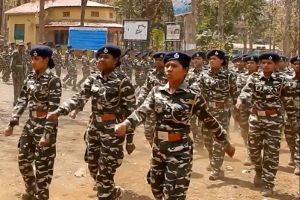
There are two options available for constituting the STPF: one is ‘Forest Option’ and another one is ‘Police Option’.
Keeping in view of the duties to be performed by the personnel of STPF, a syllabus covering subjects such as wildlife conservation, protection, forest and wildlife law among others has been prescribed.
The STPF syllabus may be downloaded here.
Why relocation?
Available data and research findings on tiger ecology indicate that for maintaining a viable population of 80-200 tigers in a tiger reserve, a minimum of 800 – 1000 sq km of inviolate forest area is required.
Tiger being an “umbrella species”, the protection offered to it also ensures viable populations of other wild animals (co-predators, prey) and forest, thereby facilitating the ecological viability of the entire forest area / habitat. Therefore, keeping the core area of a tiger reserve becomes becomes an ecological imperative for the survival of source populations of tiger and other wild animals.
Legal provisions
The Wild Life (Protection) Act, 1972, as well as the Scheduled Tribes and Other Traditional Forest Dwellers (Recognition of Forest Rights) Act, 2006, require that rights of people (Scheduled Tribes and other traditional forest dwellers) recognized in forest areas within core/critical tiger/wildlife habitats of tiger reserves/protected areas and after recognition the rights may be modified and resettled for providing inviolate spaces to tiger/wild animals.
The chapter IV of the Wild Life (Protection) Act, 1972 (Section 24) provides for acquisition of rights in or over the land declared by the State Government under Section 18 (for constituting a Sanctuary) or Section 35 (for constituting a National Park).Further, the sub-section 2 of Section 24 of the Wild Life (Protection) Act, authorizes the Collector to acquire such land or rights. Therefore, payment of compensation for the immovable property of people forms part of modifying / settling their rights which is a statutory requirement.
Relocation package
The new package for village relocation/rehabilitation which covers the provisions of “National Rehabilitation and Resettlement Policy, 2007” has been designed taking into consideration the difficulties / imperatives involved in relocating people living in forest areas:
The proposed package has two options:
Option I – Payment of the entire package amount (Rs. 10 lakhs per family) to the family in case the family opts so, without involving any rehabilitation / relocation process by the Forest Department.
Option II – Carrying out relocation / rehabilitation of village from protected area / tiger reserve by the Forest Department.
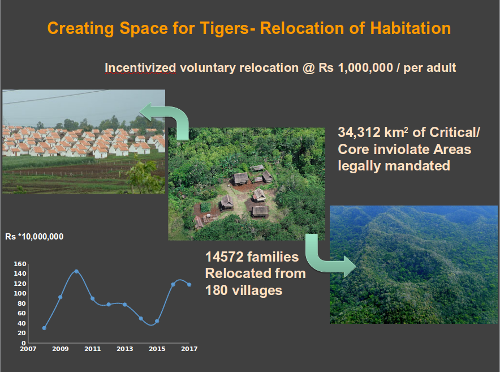
In case of option I, a monitoring process involving the District Magistrate of concerned District(s) would be ensured so that the villagers rehabilitate themselves with the package money provided to them.
In this regard, a mechanism involving handholding, preferably by external agencies should also be ensured, while depositing a considerable portion of the amount in the name of the beneficiary in a nationalized bank for obtaining income through interest generated.
In case of option II, the following package (per family) is proposed, at the rate of Rs. 10 lakhs per family:
(a) Agriculture land procurement (2 hectare) and development : 35% of the total package
(b) Settlement of rights : 30% of the total package
(c) Homestead land and house construction : 20% of the total package
(d) Incentive : 5% of the total package
(e) Community facilities commuted by the family (access road, irrigation, drinking water, sanitation, electricity, telecommunication, community center, religious places of worship, burial/cremation ground) : 10% of the total package.
Funds utilized for Village Relocation
For implementing voluntary village relocation program, so far Rs 577.64 crores has been spent for the period 2014-15 to 2020-21. The year wise fund utilization details are given below:
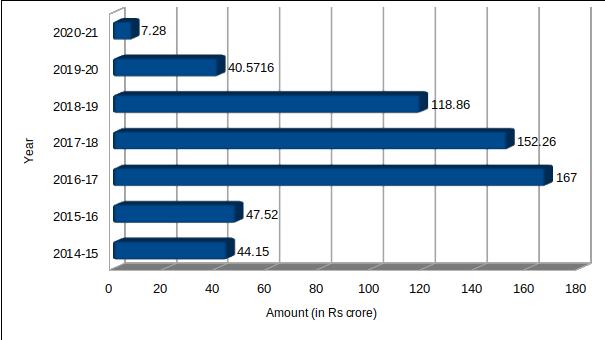
Monitoring Village Relocation
The relocation process would be monitored / implemented by the following two
Committees:
State level Monitoring Committee
(a) Chief Secretary of the State – Chairman
(b) Secretaries of related departments – Members
(c) State Principal Chief Conservator of Forests- Member
(d) Non-official members of respective – Members
Tiger Conservation Foundation
(e) Chief Wildlife Warden – Member-Secretary
District level Implementing Committee
This committee comprises of the following members and its main objective apart from implementing the relocation is to ensure convergence of other sectors for fulfilling the developmental needs of communities.
(a) District Collector – Chairman
(b) CEO – Member
(c) Representative officials from: – Members PWD, Social Welfare, Tribal
Department, Health Department, Agriculture Department, Education Department,
Power and Irrigation Departments
(d) Deputy Director of the Tiger Reserve/PA – Member Secretary
For more information on voluntary village relocation, you may refer “Format for preparation fo village relocation plan from core / critical tiger habitat” document under ‘Document ->Guidelines-> All Advisories’ section.
